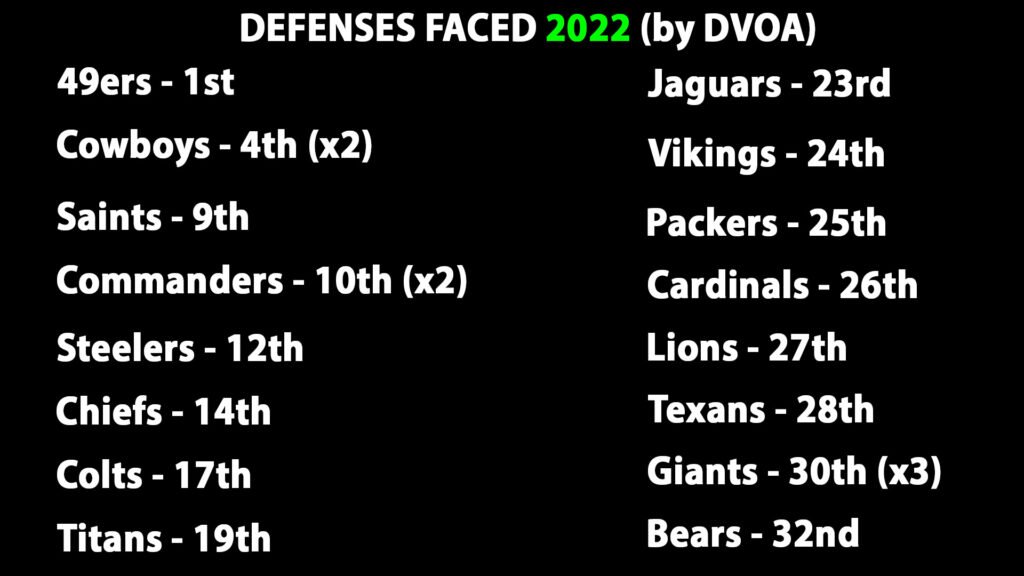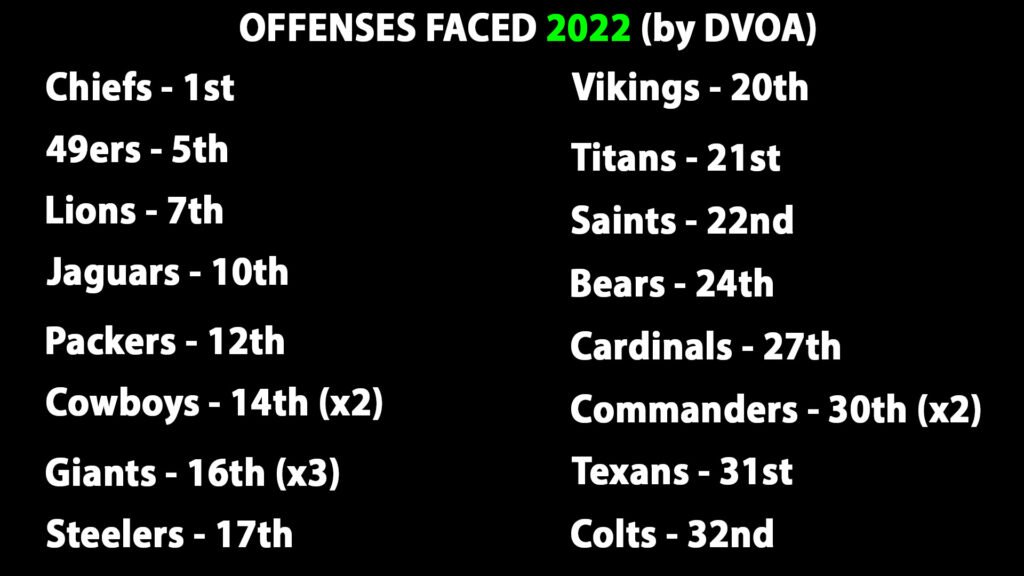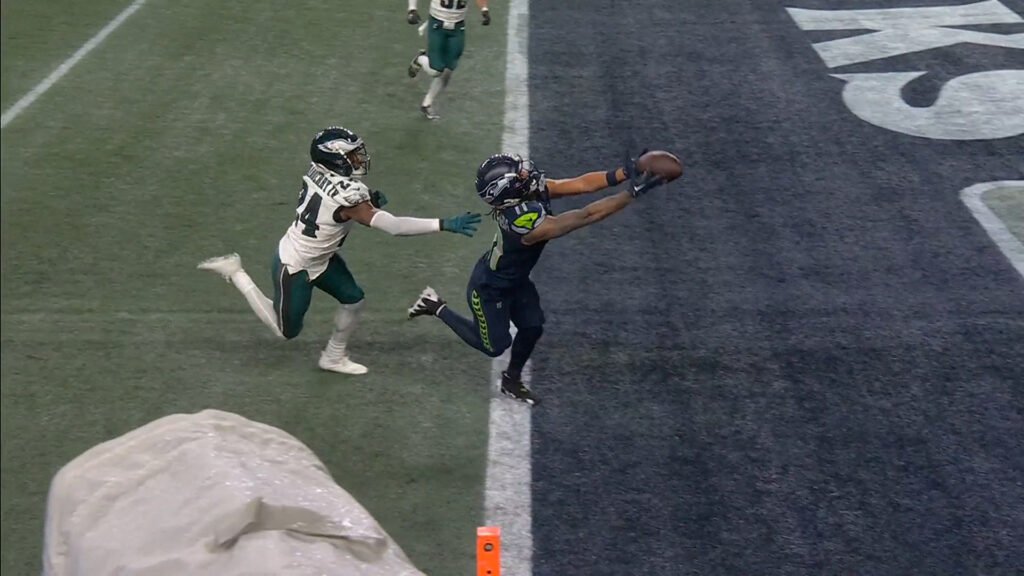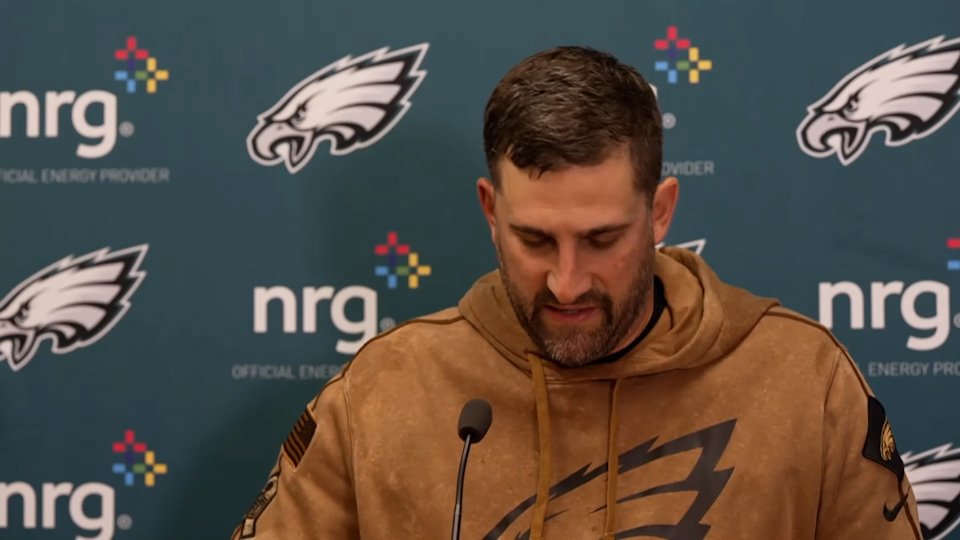It was inevitable. This season was always going to be benchmarked against the success of last season’s Super Bowl runner up team. Being so dominant all year and coming up just short of the ultimate prize in the sport convinced veterans on the cusp of retirement, like Brandon Graham and Jason Kelce, to run it back one more time. They knew just how good this team could be and they didn’t want to miss out on the chance to add to their legacies.
But what if this team wasn’t really as good as we thought? I know it’s crazy to say for a team that just came off a Super Bowl appearance that was also returning 9 of 11 starters on their offense. The defense lost some players in free agency, but they still returned four of their top five sack leaders, a starting corner duo that included a 2022 2nd Team All-Pro on one side of the field with a 2022 Pro Bowler on the other side, and replaced their top defensive tackle with a player that most scouts had as their number one prospect in the 2023 draft. Still, when you take context into account, maybe we inflated just how good we thought this team, scheme and coaches actually are. It’s important to understand because perception creates reality and the perception of this team following the 2022 season led to some decisions that this 2023 team is now paying the price for.
THE ROAD TO VICTORY
We knew the schedule for the 2023 version of the Eagles was going to be much tougher, but I think the collective fan base is overlooking just how much easier last year’s schedule was compared to this season. Last year, the Eagles faced the second easiest schedule of opposing offenses AND defenses, based on DVOA. Among that group were the teams with the four worst records in the NFL (Bears, Texans, Cardinals, Colts).
Let’s start by comparing the defenses faced last year vs this year.

Based on DVOA, the 2022 Eagles offense faced the 32nd, 30th (3 times, NY Giants), and 28th through 23rd ranked defenses, as well as two more teams in the bottom half of the standings. They only faced four top 10 defenses, the 49ers (1st), the Cowboys twice (4th), the Saints (9th) and the Commanders twice (10th).
Let’s look at those top 10 defenses they faced.
The Eagles put up 31 points against the 49ers, but let’s not forget that Brock Purdy was hurt on the first drive of the game, forcing the 49ers to play journeyman Josh Johnson, their fourth QB of the year. Still, the score was 14-7 with 1:11 to play in the first half until a sack fumble gave the Eagles the ball back at the 49ers 30-yard line. Johnson was also knocked out of the game in the third quarter and the 49ers were left with virtually no QB left to play. Not able to mount much of anything on offense outside of one touchdown drive, the 49ers were constantly on defense. Still, the Eagles averaged 3.8 yards per play. The 49ers offense averaged 3.6 yards per play without a viable quarterback for almost the entire 2nd half. I know Jalen was dealing with an injury, but just a week prior the Eagles offense averaged 6.0 yards per play and Jalen had thrown for 6.4 yards per attempt compared to 4.8 against the 49ers. Don’t let the score fool you, the Eagles offense did not perform well when faced with their biggest test of the season.
Against the Cowboys, the Eagles offense put up 26 points in their first matchup. However, it should be noted that Cooper Rush was starting at QB for the Cowboys and the offense scored 13 of those points after the defense got them the ball back in Cowboys territory via two interceptions and one turnover on downs. 20 of their 26 points came in the second quarter. Outside of two long touchdown drives, the Eagles offense mostly sputtered throughout the game. Again, against a good defense and backup QB, the Eagles offense was outgained by the Cowboys and only averaged a measly 3.9 yards per play.
The second matchup featured Dak Prescott playing against Gardner Minshew. On the road and playing with a backup QB, the Eagles offense actually scored more points (27) than they did in their first matchup, though turning the ball over four times proved to be too much to overcome. The Cowboys lone turnover was an interception returned for a touchdown, so the offense wasn’t gifted any short fields to work with this time around. The Eagles offense averaged 6.4 yards per play with Minshew starting.
Against the Saints, the Eagles had a questionable game plan. Gardner Minshew was starting and wasn’t playing well. Still, they had a 15:38 run pass ratio despite playing with a backup QB that was sacked six times while their running backs averaged 4.8 yards per carry in a game that was close throughout. The offense only scored 10 points that game.
In the first matchup with the Commanders, the Eagles put up 24 points, ALL in the 2nd quarter. The Commanders offense never got going as Carson Wentz was sacked nine times in the game, constantly giving the Eagles offense the ball back.
The second matchup, was much different when not facing a Carson Wentz led offense that was hellbent on giving the Eagles the ball back. The Philadelphia defense did force a sack fumble on the Commanders first drive, giving the Birds the ball at the Commanders 18-yard line. That turned into a quick touchdown but the offense only put up 14 points the rest of the game, plagued by turnovers and bad play overall. That’s a theme we continue to see during the 2023 season as the team has faced 6 top 10 defenses by DVOA to date.
The truth is, the Eagles beat up on some really bad defenses last season and struggled against the better units they faced. Even against bad defenses there were games they had issues. They needed a 14-point fourth quarter come-from-behind effort to put up 17 against a Colts defense ranked 17th in DVOA and team that ended with a record of 4-12-1. They scored 20 against the 26th ranked Cardinals defense. Arizona’s blitz heavy approach turned the Eagles into wide receiver screen merchants and they finished the day averaging 5.0 yards per play to the Cardinals 5.3. For reference, the NFL average yards per play last year was 5.4. The offense scored 25 against the Bears 32nd ranked defense, but they couldn’t get the running game going and turned the ball over three times. Outside of big shots to AJ and DeVonta, and a long QB Draw for a touchdown, the offense sputtered most of the day. Does that sound familiar?

Like I mentioned already, the 2023 offense has faced six top 10 defenses. In addition to that, to date, they have only faced four defenses ranked in the bottom half of DVOA. They have only played three games against bottom 10 defenses this season, they played 10 last year. People have mentioned that this offense doesn’t look the same or that Jalen has regressed. Sometimes the most obvious thing is true, the 2023 Philadelphia Eagles offense has not had many opportunities to beat up on the worst defenses in the NFL this year. Of course they don’t look as good.
Now, is schedule the only reason they don’t look as good? Short answer, no. They lost Shane Steichen at offensive coordinator. Defenses around the league paid extra attention to this offense, rightfully so, and spent extra time coming up with plans to slow the Eagles attack the past offseason. It’s inevitable when a team takes the league by storm (see: Los Angeles Rams 2019-2020; San Francisco 49ers 2020-2021; Rise of Fangio Defenses).
However, Steichen benefited from the easy schedule as well and he was the OC during the clunker games I mentioned earlier. In addition, Steichen was calling the offense Sirianni built, not the other way around. As far as the scheme goes, I’ll dive into that a little bit later.

I’ll try to keep it a little more brief as we flip to the defensive side of the ball. It’s easier to compare the offense year over year as they returned 9 of 11 starters. The defense lost a lot of talent in free agency that they didn’t adequately replace and that can’t be overlooked. Still, the 2022 Eagles defense played 10 games against offenses ranked in the bottom half of DVOA, including the 32nd, 31st and 30th (twice, Commanders) ranked teams. The defense faced off against more middle of the road offenses than the offense faced in defenses, but they still didn’t face hardly any top ranked offenses. They played four top 10 offenses – Kansas City (1st), San Francisco (5th), Detroit (7th) and Jacksonville (10th). Obviously, the Chiefs tore up the defense, the 49ers played with a fourth string or no QB for most of the game, and the Lions hung 35 on them. The Jaguars scored 21, but the game was in a torrential downpour and Trevor Lawrence was playing just his fourth game under Doug Pederson after a nightmare rookie campaign with Urban Meyer as the head coach. The Cowboys weren’t top 10, but a big factor of that was due to the games Dak missed. In the 2nd matchup, the Cowboys put up 40. The Packers 12th ranked offense put up 33 and that’s with Rodgers having a broken thumb and then having to leave the game early due to another injury.

The 2023 defense has already faced six top 10 offenses – 49ers (1st), Bills (2nd), Miami (3rd), Chiefs (5th), Rams (7th), Cowboys (9th, twice). They have faced five offenses ranked in the bottom half and just two teams ranked in the bottom 10. Again, the loss of talent was huge, but let’s not overlook the discrepancy in talent faced. Like the offense, the defense feasted on a lot of bad teams, and that’s what good defenses are supposed to do. But for all that talent they had last year, they didn’t hold up well in the few opportunities they had against top offenses.
PERCEPTION CREATES REALITY
Beating up on bad teams is what good teams are supposed to do. You can’t hold the Eagles schedule against them, they can’t control that. The issue is that perception creates reality, but unfortunately, perception can be very deceiving. Being the Super Bowl runner up gave this team, and many observers around league, the perception that the Eagles were the second best team in the NFL last year.
Getting to the playoffs is an accomplishment in itself, especially in a sport where it’s an anomaly if at least one player doesn’t suffer a multi-week injury each game. And reaching the Super Bowl is usually an indication that you’ve beat at least one serious challenger along the way. The Eagles earned the one seed through their regular season play, against a mostly easy schedule offering little adversity. Their playoff run consisted of victories against a Giants team that I don’t think any Eagles fan truly views as a top team, and the quarterback-less 49ers. Like mentioned earlier, that game wasn’t nearly as big of a blowout as the score indicates. What would be the perception of this team if Purdy didn’t get hurt? The Eagles entered the 2023 season with the perception they were at least the 2nd best team based on what happened in 2022, but were they really challenged much on their way to the Super Bowl?
Let’s not overlook the perception of the Chiefs either. In 2022 they had the seventh easiest schedule in the regular season, though they had more difficult opponents in their playoff run and actually won the Super Bowl. They came into this season as Super Bowl favorites, I don’t think many people view them as such now. I think it would be fair to say last season’s easy schedule plus the Super Bowl title helped influence the perception that the Chiefs were the best team coming into the 2023 season.
WHAT ARE THE IMPLICATIONS?
The perception of the team effects everything, from roster composition, to coaching, to scheme development. Let’s look at a few examples.

James Bradberry had a career year in 2022, giving up a QB rating of 51.8 when targeted while intercepting four passes and giving up only two touchdowns. The prior year, in 2021, the perception of James Bradberry was up in the air. In 2020, Bradberry had what was then his best year of his career. His passer rating allowed of 70.1 was the best of his career at that point and he intercepted a then career high three passes. The Giants also faced the third easiest schedule of offenses that season. In 2021, he allowed a then career high passer rating of 100.3 when targeted while also giving up eight touchdowns. Bradberry still was able to get his hands on the ball at least, reeling in four interceptions. The Giants faced the seventh hardest schedule of opposing offenses that year.
After the 2021 season, the Giants were facing cap difficulties and ultimately cut Bradberry. What’s interesting to note is that nobody was willing to trade for Bradberry and take on that contract. I understand teams probably felt James would be cut and then they could sign him, but signing a player isn’t guaranteed. The rest of the story is history, Bradberry signed with the Eagles and had the best year of his career in 2022. Bradberry’s two best years in his career came in his defenses two “easiest” seasons.
James had a great season in 2022, but he also didn’t face a lot of QBs or teams that would challenge him like top offenses would. In addition to that, the Eagles defense did have a lot of talent all over the roster that without a doubt helped aid him. He was a second Team All-Pro allowing a 51.8 passer rating. How did the stats and awards alter his perception? Did it allow the front office and coaching staff to under value some of context that led to that season? Did perception cause them to overlook that there were some signs of Bradberry slowing down? I think speed and 40 times are very overrated when it comes to most positions in football (not saying it’s not important, just overrated), but at cornerback, you have to be able to run. Bradberry was always on the slower side when it came to speed and quickness. Did they factor in that a player like Bradberry is more likely to fall off the athletic cliff faster than a highly athletic guy like Darius Slay?
Bradberry wasn’t the team’s first or second choice to resign in the offseason. They went after CJ Gardner-Johnson first, then signed Slay when CJ didn’t sign, then signed Bradberry next. It’s hindsight, but what if the Eagles elected not to resign Bradberry and used that money at safety or linebacker and invested a draft pick in what was considered a very deep cornerback draft class? Vonn Bell, Juan Thornhill, Julian Love and Marcus Epps were all better options than the safeties they started the season with opposite of Reed Blankenship. Maybe a little bit of a better offer convinces TJ Edwards to spurn his hometown and stay with the Eagles. Coming off an All-Pro campaign, Bradberry garnered a big contract from the Eagles. Even signing a different cornerback to less money would’ve allowed these options to be presented. I know, I’m talking in retrospect, but there were signs and people questioning whether resigning Bradberry was worth the money.
How has the perception of the defensive line changed? A 70-sack season was quite a feat, but it’s irresponsible to think that was going to happen again. Only four teams have ever done that, and guess what, none of those teams did it in back-to-back years. Again, the Eagles took advantage of a lot of bad offenses, quarterbacks and offensive lines. I don’t think it’s a coincidence though, that Haason Reddick, Javon Hargrave, Josh Sweat and Brandon Graham all had the best years of their careers against those offenses.
I’m not denying there was a lot of talent on that defensive front last season, there definitely was. However, when you look at this season, when playing a much harder schedule of passers and offensive lines, it’s clear that the Eagles don’t have true game wreckers like the top defenses do. They don’t have a Myles Garrett, or Micah Parsons, or TJ Watt. Reddick is awesome, and he has the sack numbers to be in the conversation as a high-end pass rusher, but he’s a tier below those guys. Both Reddick, and even more so Josh Sweat, have disappeared during long stretches this season. BG is another year older and so is Fletch, and while Jalen Carter has been an awesome rookie, he’s not an All-Pro, true game wrecker just yet. Milton Williams is a better run defender than pass rusher.
Last year they had a bunch of B to A- pass rushers that went off against bad offensive lines. They did the same thing to start this season, but as the year has progressed, they’ve played teams with a bunch of B to A+ offensive linemen and quarterbacks that do a good job of avoiding sacks and pressures. They’ve been missing their own A+ pass rusher to combat that. The situation would be better for the pass rush if the back seven could hold their own. Howie Roseman continues to go all in on the defensive line while skimping on other positions. The philosophy is to win with the defensive line but, while the line is good, it isn’t really an elite unit. Elite units don’t have the worst sack rate on third downs. Getting 70 sacks against an easy schedule gave off the perception of an elite unit. They have not been, and the combination of disinvestment in other positions has hampered the team.
Flipping to the offensive side of the ball, the same effect takes place. Overall, the offense is much more talented than the defense, which is why they’re still a top 10 offense despite playing a much more difficult schedule and encountering struggles over the last three games. Jalen, A.J., DeVonta, Lane, Kelce, Goedert are all great. Collectively, they have had one of the most talented groups in the NFL the past two seasons. It is still true though, that the perception of the Eagles offense was elevated by the easy schedule last year as well. So, we shouldn’t be as surprised when the run game isn’t working as well, especially when you factor in that Jalen has been hurt and/or not running physical like we saw last season in an effort to be healthy for the playoffs. We shouldn’t be surprised when things don’t seem to be working as easy for Jalen.
There’s talk of Jalen regressing, but the fact of the matter is that he doesn’t get to beat up on a lot of bottom feeders this year. Teams aren’t living in single high looks as much anymore, which allowed Jalen to take deep shots down the sidelines to A.J. and DeVonta. And when they do get opportunities to take those shots, they’re playing much better defenses, with better players, that make it much harder to complete those one-on-ones. Last season, A.J. and DeVonta were 5th and 20th in targets on go/fade routes. This season they’re 16th and 24th.
In regards to the regression talk, I agree to a point, but I also think he’s just not getting as many easy looks this year compared to last year and teams are forcing him to get to second and third reads more often. It’s not as if Jalen didn’t force balls to A.J., turn down open guys, scramble/bail pockets instead of hitting check downs/if first read wasn’t there, or have issues consistently stepping up into pockets last year. A lot of that was on film, but when he threw into double coverage, a lot of times players came down with the ball. Other times they ended up running the ball well to negate and ignore the bad passing games. Playing a lot of bad teams, they often had the benefit of playing with a lead, so Jalen didn’t need to press the issue like he does this year. This year, his defense hasn’t been very good so he’s had to play from behind a lot. He’s had to be aggressive pushing the ball down the field. Make no mistake, he likes hunting for big plays. He has since college and I’m sure high school as well. That aggressive risk/reward play style allows the team to come back from deficits, but can also turn into bad returns when the reward doesn’t pay out. A harder schedule, with less freedom for Jalen to run through contact, has negatively impacted their running game, while the defense has struggled to stop anyone lately. All of which has put more pressure on Jalen to win with his arm, and those bad tendencies that were masked by winning and playing with leads against bad teams are revealing themselves this year.
THE SCHEME
Perception doesn’t just impact roster construction and view of the players. I think what has been the most negative effect of playing an easy schedule has been the perception of the scheme.
Last year, this offense was all the rage. It was innovative (for NFL standards), it was multiple and it put defenses in conflicts that most teams weren’t prepared to deal with. Not to mention, the whole easy schedule, being able to run on anybody thing.
Jump to this year, and it looks like almost the same exact offense structurally. A few designs are different, they’ve added a handful of new plays and they’ve used the personnel, particularly D’Andre Swift in different ways. They’ve relied on less of the QB run game elements as well, but I guess that’s what happens when you pay a player $250 million that’s had to miss games every year he’s started. Overall, this offense looks extremely similar to last year. The perception was that this was a well schemed, great offense last season.
That’s the problem when you win a lot. Coordinators around the league spend the next offseason studying your plays, tendencies and weaknesses. They watch what other teams did and try to copy and implement that into their gameplan. It’s also a problem when you play bad defenses that struggle to stop your fastball and don’t force you to play a different way. They faced very little adversity last year. They didn’t have to add a ton of new wrinkles to their offense last year because no team made them.
Now, teams are much more familiar with their schemes and tendencies. While they have overcome that for much of the year, the good defenses are limiting what they do best. Nick Sirianni came into this year changing very little about the offense because it dominated last year. The perception of the scheme let the coaches get too comfortable. Defenses caught up while the Eagles stayed put. If they had faced more difficult opponents, if they faced more adversity last year, I think we would’ve seen more wrinkles to the offense. And let’s be honest, maybe this scheme really isn’t all that great as constructed. Steichen has taken a lot of the structure to Indianapolis, but he’s added some wrinkles that would greatly benefit the Eagles offense.
Sean McVay and the Rams faced this same issue following their Super Bowl loss in the 2018 season. They had a successful season going 13-3 with the number two offense in points and yards, but a Vic Fangio coached Bears defense upset the team late in the season. That laid the blueprint for other teams and the following year their offense dropped to 11th in points and 7th in yard and they missed the playoffs. The following year they fell to 22nd and 11th in points and yards. McVay went back to the drawing board and has since re-envisioned his offense several times. They started as a heavy outside/mid zone run heavy team with a lot of play action, bootlegs and screens tied to it. Later, his offense put a greater emphasis on drop back passing concepts, and now they have ditched the zone run heavy approach, opting for primarily gap scheme runs. Kyle Shanahan has had to deal with similar circumstances. To keep up with defenses, the 49ers, while still revolving their run game around outside zone, have had to add wrinkles, adjustments and new play calls to their offense since their Super Bowl loss as well. Neither McVay or Shanahan had all of their answers and adjustments figured out mid-season. It took an offseason of designing, preparing and installing to get there offenses back to the same level.
Right now, the Eagles are in the same boat. They’re trying to make adjustments now. Their motion rate has increased about 8% since the bye week, but it’s hard to make wholesale changes during the season. Unfortunately, I fear it will be too little too late for this season. The scheme was yet another victim to the perception that an easy schedule allows.
COMPARISON – THE THIEF OF JOY
Comparing this year’s team to last year’s team was always going to be a losing proposition, something I’ve succumbed to at times. The situations and context are very much different on several aspects and strength of competition has been a huge factor in how the past two seasons have played out. Going from an easy schedule to a hard one has been a reality to check for the organization, coaches, players and fans. Howie isn’t infallible when it comes to roster construction, Sirianni’s scheme isn’t immune to evolving defenses and Jalen isn’t a perfect quarterback. The easy schedule gave us a sense of the heights this team could reach last year, but the difficult schedule this year is a reality check that there’s still a lot of growth needed. All is not lost though, plenty of teams have had easy schedules and haven’t had near the success the Eagles have had recently. They’re also still 10-4 with a difficult schedule and have beaten several top teams this season. For the first time in two seasons, the Eagles have faced real adversity. Like the Rams and 49ers before them, let’s see if this group in Philadelphia can rebound.




